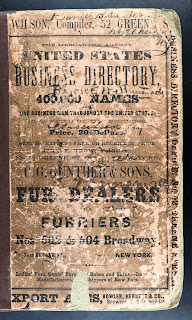Have you ever subscribed to an online newspaper archive website? I've tried them twice, but I never found anything about my relatives.
Those sites may be worth the subscription fee if your ancestors were important businessmen or socialites. Or if they were involved in a crime or a train wreck. But I never found my folks.
 |
| This directory shows me when Antonio's son James starting working. |
City directories, on the other hand, have been a great help in locating an ancestor in between census years. (See How To Squeeze Everything Out of the Census.) This can help you when you discover your ancestor is not living at the same address in 1930 as he was in 1920. The city directories between 1920 and 1930 can show you where he moved.
 |
| This directory tells me exactly when Antonio died! |
Some of these free sites may have an unfriendly interface or have no search function. You get what you pay for.
Tip: When opening a city directory, look at the table of contents so you have a rough idea of which pages to view.
Free Newspaper Websites
- Fulton History. What began as "Old Fulton NY Post Cards" now contains over 39,328,000 historical newspaper pages from the United States and Canada. The site includes a good search feature and highlights your search terms on the resulting pages. This is where I found my great grandfather's business transactions.
- Internet Archive. Type newspaper in the search box, then narrow down your results in the left column. There is so much available on this website that I may devote an entire article to it soon.
- Library of Congress: Chronicling America. This website contains digitized newspapers from 1789 through 1924 in 13 languages. That's 2,234 newspapers. The search functionality is very helpful.
Free City Directory Websites
- Don's List of Directories, Almanacs, Businesses, Registers, Street Guides. Several states are available.
- Internet Archive. Type city directory in the search box, then narrow down your results in the left column.
- Do you need city directories for a specific state? Do an online search for that state's directories. Some state libraries make their state's directories available online.
 |
| This real estate directory tells me my great grandfather owned one building and lived in another. |
A city directory may provide a missing piece to the puzzle for you.












